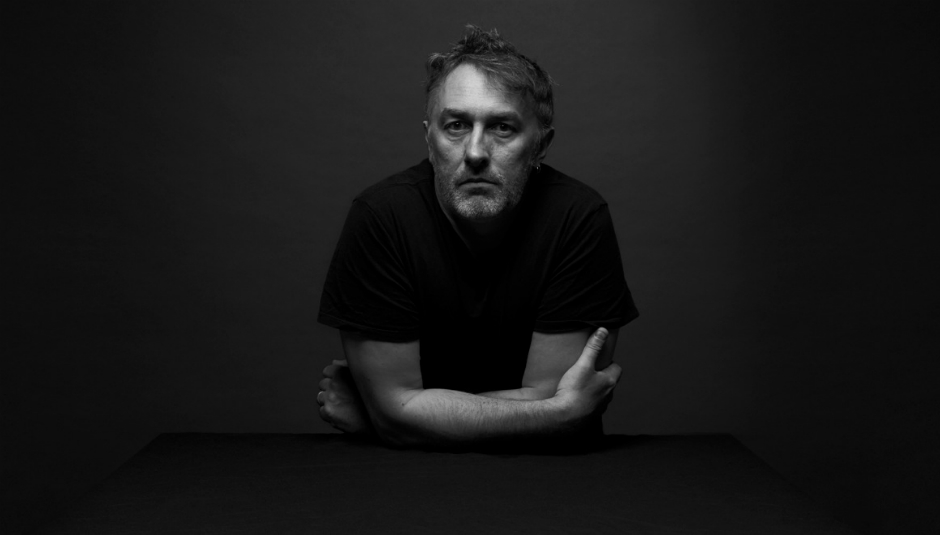I speak to Yann Tiersen a few hours before he is due to play the Gewandhaus in Leipzig, as he continues to tour his new album Eusa. A collection of ten piano songs originally released as sheet music, Tiersen decided to record the songs after playing them live. In the midst of his tour, I find Tiersen unwell with a miserable autumn cold. “At least I don’t have to sing tonight!” he laughs, before coughing and spluttering over the phone to me some more. Despite being so unwell that he clearly should be in bed with whatever the French equivalent of Lemsip is, he continues enthusiastically. Nothing, especially not a meagre cold, will stop him conveying the love he has for his latest project – a musical mapping of his home in Ushant.
It doesn’t seem like eighteen years since Tiersen’s 1998 solo album Le Phare, or fifteen years since 2001’s Bafta winning Amélie brought him into the musical consciousness of so many. Made up of tracks from his first three studio albums, La Valse Des Monstres (1995), Rue Des Cascades(1996) and the aforementioned Le Phare, the Amélie soundtrack felt like a love letter to the bustling Parisian area of Montmartre; Le Phare, by contrast, was an album where the remote, desolate landscape of Ushant inspired Tiersen to write in self-imposed seclusion on the island. Eusa, as it is known in the local Breton language, is again providing inspiration for Tiersen’s ninth studio album; however, rather than being merely inspired by Ushant, the album is Ushant, as Tiersen uses music to paint a vivid picture of his home landscape.
“I think Eusa is a small political statement because I really believe the future of the world needs to follow a regrowth,” he tells me, when I ask him about the decision to write an album about his home. “I think to find solutions is to be more open minded by focussing on the small, maybe forgetting about globalisation and consumerism and all that. This album is a focus on small places, on the small island where I live. There is infinity through a telescope; there is infinity through a microscope as well. I like to focus on these two things.”
Ushant has a sentimental significance to Tiersen. Whilst born in Brest, Northern Brittany, Tiersen and his family holidayed there when he was a child. Returning to the place to record his 1998 album was only the beginning of his relationship with the island; the location has resurfaced repeatedly in his music, the most recent before Eusa being 2014’s Infinity. Now living on the island where he is currently building a new studio, Tiersen finds solace in the unique and sparsely populated landscape that surrounds him, with a focus on the local providing the 46-year-old with particular meaning.
The map on Eusa is designed to be something the listener navigates and experiences as they progress through the album. Not wanting to tell the listener what to think or feel, the album is meant as a guide only, with listeners encouraged to paint their own mental pictures of the landscape through Tiersen’s music. Originally conceived as ten piano songs to be released as sheet music only, the title of each song is a location around Ushant. Each track is accompanied by a specific coordinate and picture, taken by Tiersen’s wife. “I liked the idea of making a musical map of the island where I live and it’s the first. I don’t know why, but I feel really connected to my home, to the island where I live. It’s always been easy to find ideas there.”
The collection of piano solos on Eusa is minimalistic and beautifully sparse, reflecting perhaps the isolation of an island located 30 kilometres off the west coast of Brittany in the Celtic Sea. It feels like an album that enables you to breathe, to take in the small local landscapes and see something greater through the vastness of the sonic landscape Tiersen paradoxically creates. For Tiersen, though, he is indelibly linked to his home, it being a living, breathing part of him. As he has said prior to the release of Eusa; “What we are is always relative to where and when we are; our sense of self is made up of what we feel to be our home. So – I am the granite stones of my house which were once rocks in the sea, I am ‘gwalarn’, the northwest wind that blows over the island of Ushant and all over Brittany, I am the sheep’s wool, I am the smell of the moor, I am the dead trees and the ones still standing, I am my music and my music is all of this. I’m not a big city and I’m not Montmartre – I am my island; I am the wilderness I have cycled through.”
The decision to record came after Tiersen toured the songs as an album, his first collection of piano solos. “I decided one year ago to release a piano book which was a musical map of the island where I live, ten piano tracks, ten field recordings. I chose the piano because it was an obvious instrument, the easiest for people to be able to play. I liked the idea of releasing something on paper. I didn’t have time to record it but after I went on tour it changed everything. I worked on lots of field recordings and made some drones of them, together with some improvisation, and that became the album.”
Interspersed between the songs themselves are the collections of improvisations and original field recordings Tiersen made on the island and then manipulated through drone. Titled ‘Hent’, something that translates from Breton to English as ‘path’, the tracks lead the listener across the landscape to each new location on the album. “It made sense to link the sheet music and the field recordings,” Tiersen tells me. “When it comes to playing live or making an album and you use field recordings without any manipulation, say a piano with the sound of sea in the background, it can be horrible and cheesy as hell. To create something and to make those two elements link together, then it needs some extra information to make them more real – they need to be transformed and then it becomes something. You can suddenly feel the place.” The recordings even come with Tiersen on tour, on a reel-to-reel machine, so the audience can experience this musical landscape as realistically as possible.
The recording of the album took place at Abbey Road’s famous Studio 1 in London, shortly after Tiersen played the Barbican earlier this year. The famous soundscape of the studio became a key element in the sound of Eusa, particularly the vastness of the large studio Tiersen worked in. “The room was so huge it affects the album a lot. It was another level of field recording in a way. At the beginning of the first track on the album, there is this rumble, this really low rumble, and actually you imagine it’s the field recording on the island but it’s not, its Abbey Road. It added a lot of character and had a huge influence on the album. The piano I used had character too.”
As well as taking field recordings, Tiersen also took a piano to one of the locations named in a song and decided to play there, as shown in the video for ‘Porz Goret’. I wonder how on earth he got a piano to the middle of such an isolated countryside field, but Tiersen is typically playful about it all. “It was a friend of mine who moved the piano,” he tells me, laughing, explaining that he owed him a favour. “And we just decided it was a good idea to find one of the locations I chose on the island and actually play the track on this location. There was this huge storm the night before but it didn’t stop us. We went really early on a Sunday morning and it was just great – I really enjoyed it actually!”
Eusa sees Tiersen again performing solo on tour, something he seems to have mixed feelings about. After touring with a band on albums such as Infinity (2014), Skyline (2011) and Dust Lane (2010), it seems as though Tiersen again longs for the collective experience touring with a band brings. “It’s been a while without touring alone; I used to tour as a band – 6 or 7 of us on stage at once. This is my first solo tour for a while and it’s quite strange! It’s really different [on your own]. Obviously it’s more fun being with your mates and partying with them [laughs], in another, it’s more relaxed on your own; it’s really different. I love both. I quite miss rock clubs though; I did two or three gigs solo with piano in rock clubs and it’s quite strange – the audience is much more receptive.”
For someone who ditched his classical academy training in favour of the yearly Route du Rock festival on his doorstep, forming his own rock band in the process, it’s perhaps no wonder Tiersen yearns, every now and again, for the collective spirit and freedom a group can bring. His early influences of Neu!, Kraftwerk and Moderat can all be somehow heard within Eusa, be it through the drone, electronic sound manipulation, or the minimalistic energy his solo piano brings. For now, however, Tiersen will continue solo and is in the midst of planning his next ambitious project – something that takes his relationship with the landscape and music even further.
“In every album, there are roots for the next one. Eusa is a transition. My next album will be all field recordings. Eusa is the root of my next album which I will record on location around the world, outdoors. It’s a big project and the idea is to make acoustic music inspired by field recordings in another natural environment to bring my island in from other places in the world. It’s a long process and I have a lot of work to do!” The project is well underway, as Tiersen’s own Work in Progress blog explains. Next year, he will travel the world searching for resonant, isolated environments where he can work, “letting the wilderness find its way into my music,” as he writes on his blog.
The field recordings and improvisation on Eusa seems to have given Tiersen a new found freedom. “I needed to have this shifting moment, getting from one place to another, to give ambience on the album, from a drone to another drone. It is quite strange, like being transported from one place to another. It was really inspiring to do some improvisation; at Abbey Road I would wait and then do a big improvisation with those field recordings and editing. Improvisation needs context. Abbey Road was so special and so strange: to be in this huge room with just a tiny light to be focussed. It was a really unique inspiration. I guess I am thinking of doing some gigs with improvisation now too.”
As the Eusa tour comes to a close in November, Tiersen is sticking firmly to the local for the time being. “I am focussing on my homeland and I want to share that now because I want to have something to share. Knowing where you live, and the importance of this and the ecosystem around you, makes you richer. When you know this, then you have something special to share with other people. The album is a juxtaposition rather than an exploration – it’s an organic link. I live there and so the island became a part of me and so part of my music by extension.”
EUSA is out now on Mute Records.























